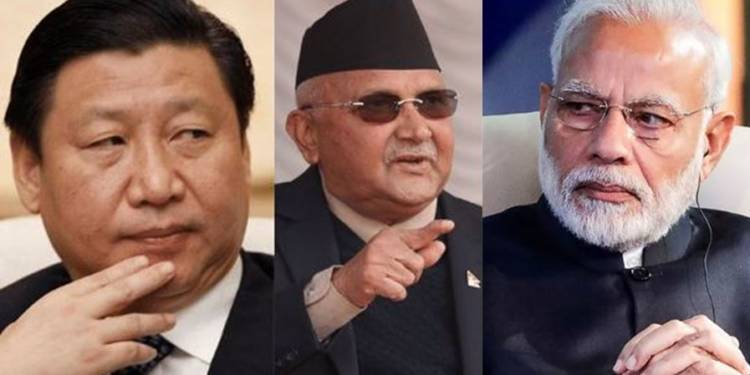The Himalayas have become a militarily hot zone in the past seven months, with two Asian giants – India and China getting involved in a tense military standoff since May, which also witnessed a bloody and violent clash between the two sides in June, resulting in 20 Indian fatalities, and innumerable PLA troop deaths and casualties. Nepal, meanwhile, thought this as an opportune time to flex some muscle geopolitically, which is why the Communist regime of the Hindu nation, at the behest of the CCP, took a series of anti-India decisions, sending ties between the two culturally intertwined countries into a freeze.
Of late, however, the K P Sharma Oli regime of Nepal seems to have realised its folly, which is why it is once again tilting the geostrategic scales in India’s favour, much to the Chinese Communist Party’s chagrin. With Nepal now being a country which has made itself available to be won over by any of the two Asian giants, a great Indo-China powerplay has started in the region. Both the countries are trying their level best to throw in the last dice in order to win over Nepal. Nepal itself, however, seems more inclined to go India’s way.
In recent weeks gone by, a series of high-level meetings have taken place between India and Nepal. The most recent high-ranking Indian official to visit Kathmandu is, of course, Foreign Secretary Harsh Shringla, who called upon his Nepalese counterpart, and also met Prime Minister Oli. Shringla also met the Nepalese President and Foreign Minister.PM Oli conveyed “Nepal’s desire to build on the momentum in the bilateral relationship and enhance the level of bilateral engagement.”The contentious boundary issue also came up for discussion between the two sides, and a Nepalese release noted, “both sides shared their perspectives on boundary matters and discussed ways to take it forward under the appropriate bilateral mechanisms.”
Late last month, India’s intelligence (RA&W) chief also visited Nepal, and called upon PM Oli, assuring him that India will not allow interruption in the friendly bilateral relations with Nepal and resolve all outstanding issues through dialogue. The visit by RA&W chief came ahead of the Indian Army chief, Gen. Manoj Naravane visiting Nepal to reset bilateral ties between both the countries. The visit was significant as General Naravane became the highest-ranking Indian dignitary to meet the Nepalese leadership in the backdrop of the Kalapani territorial dispute. In fact, Gen MM Naravane was even conferred the honorary rank of General of the Nepali Army by President Bidya Devi Bhandari.
Foreign Secretary Harsh Shringla has therefore become the third Indian official to visit Nepal for furthering the process of bringing about a thaw in Indo-Nepalese ties. The series of high-ranking visits by India comes after KP Oli had signalled that his government was interested in restoring bilateral ties with New Delhi. In accordance with the same, he removed his pro-China defence minister Ishwar Pokharel. Pokharel was the reason behind the provocative and unnecessary stance on the military relations between India and Nepal, under which Nepali soldiers are recruited in the Indian Army.
Read more: Nepal wants India help reduce dependence on China but India has some conditions
Oli had even stopped the publication of a fictional book of Geography whose sole aim was to send ties between the two cultural allies into a downward spiral. Then, during the Vijayadashami greetings, PM Oli even emitted the areas of Lipulekh, Kalapani and Limpiyadhura from Nepalese territory. It was the cartographic depiction of the said territories in a revised map which had irked New Delhi in the first place, and Oli not using the new Nepalese map for extending Vijayadashami greetings was seen as a positive sign by India, after which the string of high-level meetings between the two countries was seen.
Read more: After removing its pro-China defence minister, Nepal begins a battle against China at the border
The same has not been given a miss by China, which due to its frustration, has deployed its wolf-warrior Hou Yanqi to try and salvage the Chinese stronghold over Nepal. The Chinese Ambassador to Nepal on Tuesday evening met Prime Minister KP Sharma Oli amid reports of yet another rift in the Nepal Communist Party. The meeting lasted for two hours but is largely being seen as a step by the CCP to try and counter India’s aggressive diplomatic push to sway Nepal to its side once again. However, the CCP this time round is in a disadvantageous position, and negotiating to replace India as Nepal’s godfather will not be easy for Xi Jinping.
China has usurped Nepalese lands in various bordering districts of the Himalayan country. The paper dragon has occupied land in at least 11 places of four Nepali districts. The areas occupied by China are of strategic importance as most of the areas are the catchment areas of rivers. Earlier in June, China quietly occupied Nepal’s Rui village and again in August, the dragon grabbed lands in its seven bordering districts. As such, it would not be particularly surprising if Nepal is now averse to the idea of China exercising excessive influence in Kathmandu.
The same would then become a driving force behind the restoration of glorious Indo-Nepalese ties. While the CCP thinks that it can buy out Nepal and make India irrelevant in the Himalayan country, the Nepalese leadership seems to have got some sense knocked into it, which is why it is clearly siding with India in the ongoing powerplay. The best part is, Nepalese people and media too are vociferously siding with India, and are ensuring that China is kicked out of their country.

